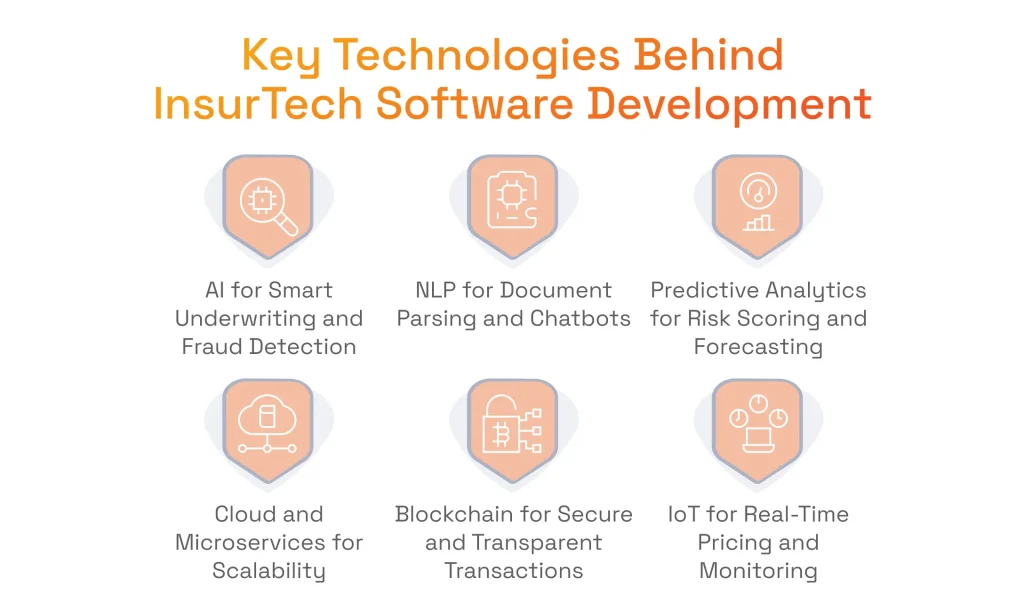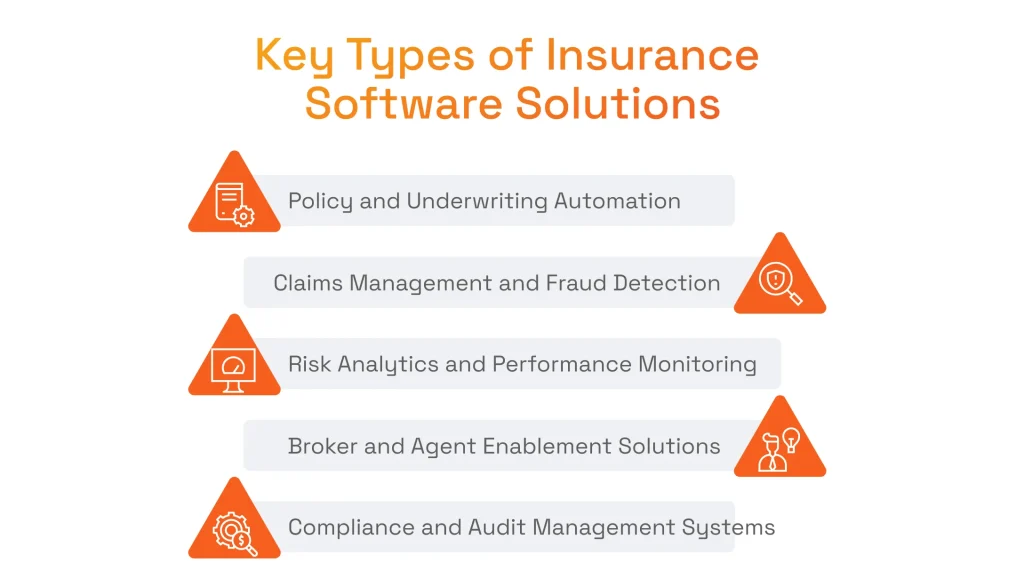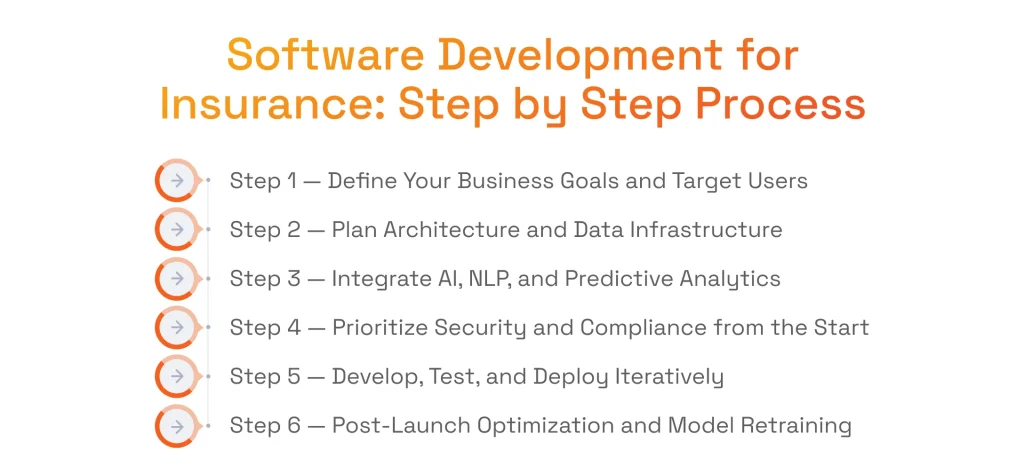Launching a new product takes months, not weeks. Customer expectations are almost impossible to meet. IT maintenance costs continue to climb.
These are all symptoms of one root problem: rigid, outdated legacy systems. For decades, these platforms were the industry’s stable core, but they have become a barrier to growth. They are difficult to update, can’t connect to new data sources, and prevent meaningful automation, which is the key driver in insurtech. Many carriers now choose to build insurance software that is tailored to their needs.
Custom insurtech software development is a strategic approach that focuses on building smart, scalable platforms. These advanced solutions use AI, predictive analytics, and cloud infrastructure to deliver more innovative and customer-centric solutions. In this article, we’ll outline the technologies, processes, and solutions that define software development for insurance.
Understanding Modern Insurance Software Development
Insurance software development is, at its heart, building the core engine of an insurance carrier. It’s the collection of systems that manage policies, handle claims, assess risk, and manage customer relationships, often using AI for customer behavior analysis. For a long time, this meant running the business on static, siloed platforms that were stable but incredibly difficult to change. This describes most of the legacy software used in insurance companies today.
The old model is no longer competitive. The new standard is an AI-driven ecosystem that integrates data from telematics, IoT devices, and customer interactions. This shows the combined power of artificial intelligence and the Internet of Things. This transition redefines how insurers manage risk and serve customers, driven by clear business goals:
- Operational efficiency through widespread automation.
- Enhanced accuracy in risk assessment and pricing.
- Personalized customer experiences that build loyalty.
- End-to-end compliance and data transparency.
These goals are the foundation for modern insurance software applications.
InsurTech Software Development Tech Stack
A modern insurtech platform is not a single product. It’s an ecosystem of technologies working together to turn data into decisions.

The intelligent layer is driven by artificial intelligence and machine learning (AI/ML). This automates complex tasks, such as underwriting risk assessment, and spots fraudulent claims that a human adjuster might miss. Understanding the business impact of Big Data and AI is the first step to scaling. A modern insurance software solution is built on this intelligent layer.
Dmytro Tymofiiev
Delivery Manager at SPD Technology
“Clients often want to start with AI, but we advise them to start with their data infrastructure. Deciding how to choose the right technology stack for insurance software often starts with the data strategy, not the application layer.”
This entire system runs on cloud computing, which provides the necessary scale, security, and resilience. Cloud-native architecture adoption is expected to add the most growth in the compound annual growth rate in the insurtech industry.
Moving to the cloud helps insurers decommission expensive and inflexible on-premises data centers, just one of the many cloud computing infrastructure benefits. The fuel for this engine comes from predictive analytics and Big Data. These tools analyze vast, complex datasets to create highly accurate risk scores, forecast potential losses, and identify customers at risk of churn, which is the core function of modern insurtech software development.
Other technologies provide specialized, high-value functions. Blockchain is increasingly used to create transparent, smart contracts that can automatically validate and pay out claims. IoT and telematics provide a new stream of real-time behavioral data that allows insurers to offer proactive risk prevention and create new usage-based policies.
Key Types of Insurance Product Development Software
Building a next-generation platform means focusing on specific high-impact business problems. The right insurance software technology depends on the specific business problem. We find that the greatest value comes from developing five solution types, each designed to optimize a critical part of the insurance product development software value chain.

These components are not built in isolation. They are designed as parts of a modular ecosystem. Data from a claim, for example, feeds the risk analytics platform. An insight from the analytics platform, perhaps from demand forecasting with machine learning, might then be used to update the underwriting automation rules.
#1. Claim Management and Fraud Detection
Claim management is the most automated process in insurance software. The claims process is the moment of truth for every policyholder. This software is built to optimize the entire journey, starting with OCR (optical character recognition) to instantly capture data from a “first notice of loss.”
AI-driven rules engines, a core component of fraud detection software development, then verify the claim details against the policy, check for predictive fraud indicators, and in many cases, approve the payout instantly. This reduces processing costs, reduces fraud-related losses, and builds customer loyalty through transparent and fast resolution. This part of software development for the insurance business often provides the highest ROI, especially for commercial insurance software applications.
#2. Policy and Underwriting Automation
The goal of this insurance product development software is to make your underwriting process faster, more innovative, and more consistent. It streamlines the entire workflow: from initial quote to final policy issuance. By applying automated risk scoring, real-time pricing models, and robotic process automation (RPA) for back-office tasks, it eliminates guesswork and manual data entry. This allows underwriters to focus on complex and high-value cases rather than routine paperwork, and it gives customers a much smoother application experience.
#3. Risk Analytics and Performance Monitoring
Executives need a clear, accurate, and up-to-the-minute view of enterprise-wide risk. Performance monitoring tools, backed by professional data analytics services, deliver this. They feature data visualization dashboards that track key metrics like loss ratios, claim frequencies, and new policy acquisition costs. More advanced platforms include predictive models that allow leaders to simulate different market scenarios and see their potential impact, enabling data-backed strategic decisions.
Want to see how modern data practices are changing strategic risk management? Read our article on data analytics in insurance.
#4. Broker and Agent Enablement Solutions
Your intermediary channels — the agents and brokers who sell your policies — need tools that help, not slow them down. Enablement solutions are built for productivity. These are often mobile-first dashboards that give agents everything they need in one place: the ability to generate quotes, access client policy information, manage renewals, and get digital signatures. Providing a modern and easy-to-use toolset makes you the preferred carrier for top-performing agents.
A core part of enabling agents is giving them a central tool to manage relationships. Learn more about custom insurance CRM development.
#5. Compliance and Audit Management Systems
Managing compliance across multiple states or countries is a significant source of cost and risk. These systems are specifically designed to automate governance and simplify audits. They create a complete, unchangeable audit trail for every policy change, rate adjustment, and claim payment. With features like automated policy review against a library of regulations and alerts for potential issues, a strong insurance software solution reduces compliance risks and makes the audit season far less painful.
Software Development for Insurance: Step-by-Step Process
A successful insurance software project moves methodically from a business concept to a fully operational, secure, and intelligent platform. This is one of the advantages of strategic technology consulting; we follow a straightforward multi-stage process to ensure nothing is left to chance and that the final product delivers on its core objectives. This is our proven approach to insurance software system development.

Step 1: Define Business Goals and Users
The first step in software development for insurance is a discovery phase to define success. We work with your stakeholders to identify the specific insurance vertical (P&C, health, etc.) and the primary problem we are solving. We clarify the exact metrics for success: whether it’s cutting operational costs, improving customer retention, or reducing claims resolution time. This clarity is vital for building insurtech at scale. As an experienced insurance software development company, we also define the key user roles to guide the entire design and development process: agents, underwriters, policyholders, and adjusters.
Step 2: Plan the Architecture and Data Foundation
Once we know what we’re building, we map out how. The standard for any new insurance platform is a flexible, API-driven, microservices-based architecture. This design allows for true scalability and easier upgrades. We then plan the data infrastructure to power real-time analytics, typically a centralized data warehouse or lake.
The entire blueprint is built on a secure cloud foundation that meets HIPAA, SOC 2, or GDPR requirements. It includes a clear plan for interoperability with your existing systems, such as CRMs and ERPs. This planning highlights the importance of data integration.
Step 3: Integrate AI and Predictive Analytics
This is where the platform’s intelligence comes to life. We integrate machine learning models to automate critical functions, such as risk evaluation for underwriting and fraud potential scoring. We apply natural language processing (NLP) for business to read and parse documents, or to power chatbots for instant customer service.
At this step, we also enable predictive models for customer lifetime value and churn prevention, turning your data into a strategic tool.
Learn more about the existing opportunities and upcoming trends for this technology in our article on AI in insurance.
Step 4: Embed Security and Compliance
Security and compliance are integrated from the first line of code, not bolted on at the end. This DevSecOps approach is essential in the insurance industry. It means applying end-to-end encryption and tokenization for all sensitive data. We implement strict data retention policies based on your regulatory needs and built-in compliance modules for ISO, NAIC, and GDPR. Automated audit trails and anomaly detection are used to ensure full accountability and system integrity.
Step 5: Develop, Test, and Deploy
We use an Agile development methodology, which means we build in iterative sprints. This keeps the process flexible and allows you to see and test new features regularly. Quality is enforced through a heavy emphasis on automated testing (unit, regression, and load) to catch bugs before they reach production. Our CI/CD pipelines automate deployment and version control, allowing us to release updates faster and more reliably.
Step 6: Optimize and Retrain After Launch
A modern software system is a living asset. After launch, we monitor the key business metrics and system performance (like uptime and NPS). We establish a feedback loop for continuous UX improvements. Critically, AI models can “drift” and become less accurate. We implement a strategy to retrain your models with new data to ensure they remain precise and fair. This final step is a permanent part of the modern insurance software development lifecycle.
Common Challenges in Insurance Software Development (and How We Solve Them)
In our experience, every major insurance software project runs into a similar set of hurdles.

Our value isn’t just in our technical skill, but in our playbook for solving these known blockers from day one.
Dmytro Tymofiiev
Delivery Manager at SPD Technology
“Everyone wants to build a new AI platform, but they forget the 30-year-old mainframe in the basement that still processes 90% of their claims. You can’t ignore the legacy system. The key isn’t a ‘big bang’ replacement; it’s a modular approach with APIs. We build bridges, not just new islands.”
The most common challenge is legacy system integration. A “big bang” replacement is simply too risky for most carriers. We opt for a modular modernization, using API middleware to build a secure bridge between your new cloud applications and your existing core. This is one of the most common challenges we are asked to solve as an insurance software development company.
This immediately helps solve the next problem: data fragmentation. With data scattered across different silos, we design and build governed pipelines to pull it into a centralized data lake. This creates a single reliable source for all analytics. Of course, that centralized data must be managed. The complexity of compliance across multiple jurisdictions (like GDPR or NAIC) can be daunting. We handle this by building automated audit trails and regulatory frameworks directly into the application’s architecture.This same discipline applies to the AI models. An algorithm can develop bias or “drift” over time, leading to decreased accuracy. We control this through explainable AI (XAI) and by implementing a clear retraining schedule to ensure models remain precise and fair.
Why Choose SPD Technology as Your Insurance Software Development Company?
Choosing a software partner is the most critical decision in a modernization project. You need an engineering team that speaks the language of insurance, not just code. This includes understanding specialized applications, like using chatbots and virtual assistants in insurance, and the core systems they connect to.
An insurance software provider needs to understand the high-compliance and high-stakes nature of insurance. SPD Technology is a technical engineering company offering insurtech development services with deep domain experience across the FinTech, HealthTech, and insurtech sectors. This cross-industry knowledge means we don’t just build to spec; we understand your business logic and regulatory pressures, and know how to build secure, auditable systems from the ground up.
We specialize in custom AI solutions development and analytics-powered solutions that create a competitive edge, with proven experience in predictive modeling, risk analytics, and NLP automation. We believe in end-to-end ownership, acting as your strategic partner from the first architectural drawing to long-term, post-deployment optimization.
Our Experience in Real-World Case Studies of Software Development for Insurance
When Pie Insurance needed to modernize their billing and data operations to keep pace with their success, they turned to SPD Technology. We delivered a comprehensive re-architecture of the company’s warehouse and billing infrastructure.
Revamping Billing and Data Management Infrastructure
This project focused on rebuilding Pie Insurance’s core data and billing infrastructure. The client’s existing systems couldn’t keep up with their success. We were brought in to engineer a new data management solution that could scale.
- Business challenge: Pie Insurance was scaling faster than its systems could handle. Their billing and data platforms were creating operational friction and couldn’t provide clean data for reporting.
- Our Solution: Our team was brought in to re-architect their data management solution. We designed and built a highly scalable data warehouse and refactored their entire billing system to improve efficiency.
- Our Results: By streamlining payment workflows, we saved the customer success team 40% in operational time and drove a 3x increase in automated clearing house users, resolving policy termination issues. The improved UX and new options also led to a 30% increase in average checks.
Learn more about the case and how our experienced team handled it.
Creating an API Service and BI Visualization for Embedded Insurance
This project involved building a two-part solution for a client in the embedded insurance domain. The client needed a high-performance, scalable API to deliver data to partners, and a powerful internal Business Intelligence (BI) solution to track their own performance. We were tasked with designing and building both systems concurrently.
- Business Challenge: An embedded insurance provider needed a more robust and scalable way to deliver data to its partners. They also required an internal BI solution to track business performance.
- Our Solution: We developed a high-availability API service to act as the central hub for all partner data integrations. At the same time, we built a full-featured BI solution with custom dashboards to visualize key metrics.
- Our Results: The new API service provided a fast, reliable, and secure data flow, improving partner satisfaction. The BI dashboards provided their leadership and operational teams with clear and actionable insights to make smarter business decisions.
Ready to Build Your Intelligent Insurance Software?
The future of insurance is predictive, not reactive. Intelligent insights, smart automation, and a personalized approach to customer service power the developments in insurance software. In this new environment, success requires a careful balance of three elements: clean data, scalable technology, and a deep understanding of compliance.
This is what SPD Technology builds. We create advanced software ecosystems that allow insurers to manage risk more effectively and serve customers better. We have the engineering and data science expertise to help you build your future-ready platform. Contact our team as your trusted insurance software development company to start building your solution.
FAQ
How do you start developing custom insurance software from scratch?
We begin with a discovery phase. Our team works with your stakeholders to define the business problem, map user roles (agents, underwriters, etc.), and identify key metrics. We then design the system architecture and technology stack before starting development.
What are the differences between cloud-based, on-premises, and hybrid insurance software deployment options?
On-premises is hosted on your servers, giving you complete control but requiring high capital and maintenance costs. Cloud-based (SaaS) is hosted by a vendor, offering scalability and lower upfront costs. A hybrid approach mixes both, often keeping sensitive data on-prem while using the cloud for flexible applications.
What are the typical ongoing maintenance and upgrade costs for insurance software after initial launch?
Ongoing costs typically range from 15 to 25% of the initial development cost annually. This covers secure cloud hosting, essential security patches, regulatory updates, new feature development, and the continuous monitoring and retraining of any AI models.


